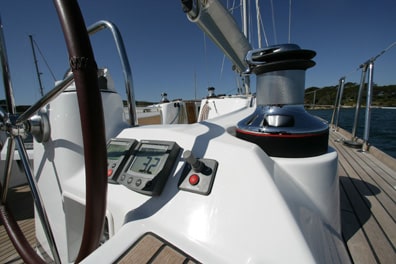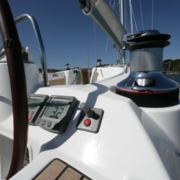Starting the Engine – Getting Familiar with a Charter Boat
Regarding the starting procedure, we’re assuming that since you’re actually commanding a sailboat you pretty much know how to turn the key and all the other safety precautions. IE you should have done this a few times before.
The only thing we’d really point out here is to make sure that you see water coming out of the engine exhaust and ensure all the dock lines INCLUDING THE YELLOW DOCK LINE (THE POWER CORD) are disconnected before you engage the gear. That’s a pretty embarrassing thing to do on the dock in front of all the other charterers. Additionally, since you’re so excited to get underway, check the traffic in front of you and also check for floating buoys in front of you. In charter marinas, there are a ton of floating ropes and things in the water and it’s also embarrassing to get your prop tangled in the first 20 ft of your voyage. I have seen it done!!!!!
Next, we’ll cover a little stuff to ensure you have enough battery juice so that something happens when you turn the key.
Starting Battery:

If this is the system then – great! You’ve got no worries – too much. The engine battery system will be charged by the engine and the engine will also charge the house battery system automatically.
In the unlikely event that the systems are not isolated then you’ll see a 1-2-BOTH switch. Your job is to constantly make sure that you’re only draining one bank of batteries while you’re not running the engine and saving the other bank for the engine start. So use this rule – whenever you switch off the engines, turn one of the battery banks off.
And here’s another little trick with some boats – we’ve noticed this in Beneteaus. The battery bank 2 is for the engine. If you switch off battery bank 2 you can neither start nor stop the engine. IE Battery bank 2 has to be on to start and stop the engine but the house can drain from bank 1 or 2 if both are on. The engine can draw from battery bank 1 or 2 if they are both on. Confused? To simplify, once you verify if a boat has this system just switch bank 1 off as you prepare to leave the dock. That way there’s always a backup.






